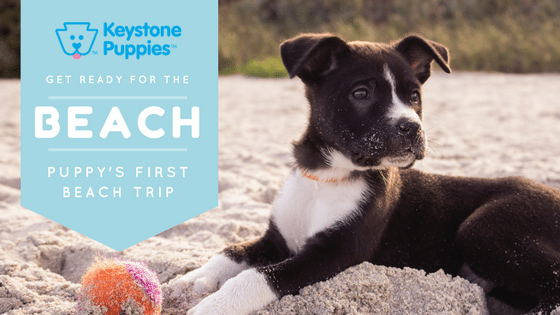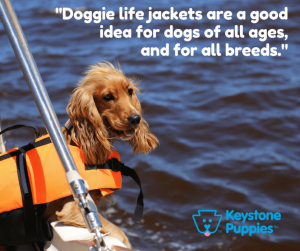5 Beach Tips for Puppy Owners

Summer is finally here, and for many people on the East Coast, that means trips to the beach. If you’ve never brought your dog to the beach, you may be nervous about the combination of sun, sand, water, and lots of new people. But with a little planning, you can create a beach trip that’s fun for you and your dog.
Before you decide to bring your canine pal along, remember that many beaches don’t allow dogs because of health and safety concerns. Even beaches that allow pets usually limit dogs to one part of the beach, and other rules and regulations often apply. As a responsible dog owner, it’s up to you to do the research prior to the day of your trip. Call ahead or check out their website to learn their regulations.
If you want to plan a beach trip around your pup, click here to get a list of dog-friendly beaches from all over the country.
Once you’ve decided on a beach, you’ll need to do things a little differently to accommodate your puppy. We’ve put together a list of tips that will help you and your dog make the most of trips to the beach.
Tip 1: Stay Cool and Hydrated
Dogs, like people, get easily dehydrated at the beach. That’s why you’ll want to bring a portable water bowl along, and lots of water. Encourage your dog to visit his water bowl frequently. If you see your pup lapping up ocean water, stop him immediately. Canines don’t have the ability to process lots of salt, so drinking ocean water could make your dog sick, or even kill him. The bacteria and parasites in the water can also harm your pet. Salt water is especially dangerous for puppies, dogs with illnesses, or older dogs.
If you plan to spend several hours at the beach, you’ll have to watch for overheating. Bring a thick towel for your dog to keep him off the hot sand. You should also provide shade in the form of a large umbrella or a tented structure. Make sure your pet drinks plenty of water, and limit exercise in the sun on hot days. If your dog starts to pant excessively, drools loses coordination, vomits, develops diarrhea, or collapses, he’s probably experiencing heat exhaustion. Get him into a cool spot, rehydrate him, and once symptoms abate, consider taking him home to recover.
Tip 2: Be Careful Around Water
Never assume your dog is a strong swimmer. While some breeds like Chesapeake Bay Retrievers, Newfoundlands, Labrador Retrievers, and Portuguese Water Dogs tend to be good swimmers, other breeds like Pugs, Welsh Corgi Pembrokes, Dachshunds, and Basset Hounds are very poor swimmers. No matter which breed you have, if this is your dog’s first time in the water, he will have to learn to swim. Your dog’s physical condition will also impact their swimming abilities. Very young, very old, overweight, or out of shape dogs will tire easily. Click here to get more tips from PetMD on teaching your pup to swim.
Even if your dog is a strong swimmer, waves, currents, and undertows can quickly overwhelm all types of dogs, including water rescue breeds. Furthermore, if a medium or large dog panics in the water, it may be difficult, or even dangerous, for you to rescue him. That’s why doggie life jackets are a good idea for dogs of all ages, and for all breeds.

Even if your dog is an experienced swimmer, always keep an eye on your him in and out of the water and watch for signs of physical exhaustion or heat stroke. Regardless of the breed, you canine should never be left in the ocean unsupervised.
Tip 3: Avoid Sunburn and Paw Injuries
While pup’s coats do provide some protection from the sun, your dog still needs sunblock on his belly, on any area of his ears exposed to the sun, and on his nose. Dogs with white fur, short hair, or pink skin are especially susceptible to sunburn. Use a veterinary formulated sunblock and apply at least 30 minutes before they get into the sun for maximum effectiveness. Never use human formulations of sunscreen on your pet. Remember that sunblock should be reapplied regularly. Check the product’s instructions to determine how frequently it should be reapplied.
On warm days, hot sand can be painful for your puppy’s paws. Look for ointments that protect paws on hot pavements and sand, available online and in most major pet stores, or consider using paw booties until you get to the water’s edge.

Sand can also hide debris, cut glass, or other hazards. Watch where you and your dog are stepping. Running on sand is more tiring than running on grass, so keep an eye on your dog’s energy level and watch out for physical or heat exhaustion.
Tip 4: Leash Your Pup
Once you arrive at the beach, leash your pet before leaving the car. Leash laws vary from place to place, so leashing your dog helps you avoid fines. Leashing your canine pal also keeps him safe in the parking area, where drivers may be not looking for dogs as they back out of spaces.
Leashed dogs also increase the comfort of the people and dog owners around you. Responsible pet owners know that leashing is one of the best tools for ensuring a calm and conflict-free outing.
Tip 5: Keep Your Dog Safe
Beaches present a lot of safety challenges to very young, very old, or ill pups. Never bring a puppy less than 14 weeks old to the beach. Be careful when bringing older dogs to the beach, and keep sick pups at home.
Stay Up to Date on Shots
Make sure your dog up to date on his Bordetella shots, heartworm medicine, and make sure that flea and tick prevention measures are in place. Some areas recommend dogs get Lyme disease vaccines. Check with your vet.
Monitor Other Canines
Dogs love the beach, which means you’ll probably encounter other dogs on your visit. Stay relaxed and be friendly with other dogs and people. Remember that your dog takes many of his cues from your body language. Even if you keep your distance, making eye contact and saying hello to other people and dog owners (even if they don’t reciprocate) shows your dog you are comfortable in this environment. This comfort allows your pup to relax as well. At the same time, stay alert and monitor the behavior of oncoming dogs. If you sense aggression from other dogs, or if your pup is exhibiting aggression, calmly walk away from oncoming canines.
Stay Away from Strangers
Busy beaches are challenging for dogs, that’s why so many crowded beaches ban dogs. The good news is that dog-friendly beaches tend to be much less populated, allowing a calmer, more private outing for you and your dog.
Children love dogs, and many young children will run to your dog without your permission or the permission of their parents, which can make some dogs nervous. Even calm dogs can be surprised by a squealing child. If you have any doubts about how your dog will react to any child, calmly tell the child to stay away. Never test your dog’s comfort with strangers.
If you don’t already know the children, don’t let kids under the age of five pet your dog. Pre-schoolers simply can’t be trusted to treat your dog gently, and your pup’s only protection against painful pulls and grabs is a nip or a bite. Don’t risk it.
And remember, although your dog is undoubtedly adorable to adults and children, you do not owe anyone the chance to pet your dog. Allowing your dog to maintain a comfortable distance from strangers is always the safest policy.
*****
Pet Need Home Puppies cares about the health of your canine pal. No matter which breed of dog you choose, outdoor activities are essential to the mental and physical health of your pup. Beach trips are a fun way to spend time with your puppy, but be prepared, watch for heat exhaustion, provide sunscreen, and invest in a doggie life jacket. If you haven’t decided which breed of dog is right for you, research over 200 breeds here. Want to search for your new puppy now? Click here to get started.






